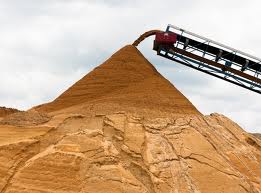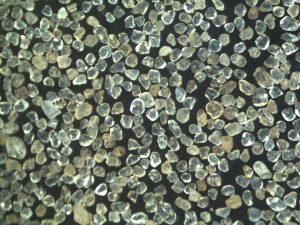 When I was younger, I used to love the tv series “Unsolved Mysteries,” with Robert Stack. Mr. Stack would be in a trench coat every episode, with clouds of fog rolling in the background.
When I was younger, I used to love the tv series “Unsolved Mysteries,” with Robert Stack. Mr. Stack would be in a trench coat every episode, with clouds of fog rolling in the background.
At the end of some episodes, they would feature an update, “Solved Mysteries.” In some cases, the show itself had led to the mystery being solved!
Today, let’s “solve” a few sand testing mysteries that might be bothering you.
1. My sand is pure white, can it be used as frac sand?
Getting into the frac sand market requires a lot of factors going your way – strength of the sand, transportation logistics, your ability to get the sand cleaned economically, and a great many other things.
My area of expertise is doing some lab testing on your sand to determine its performance, primarily its crush strength. I have other experts to refer you to, with regards to the other areas and pricing, etc.
Crush strength is a key measure for how the sand will perform down hole, so it makes sense that crush strength is a primary factor for an engineer deciding what kind of sand he will send downhole.
In my experience, the crush test – even an initial crush test – is the most objective way to get an idea of whether or not your sand can become frac sand. With regards to its color, I have seen low AND high strength white sand, and I have seen low AND high strength brown sand! You don’t know until we get it into the crush press.
 2. What stress should we crush sand at?
2. What stress should we crush sand at?
There are 2 schools of thought here, and I usually recommend one or the other depending on a client’s circumstances.
The first school of thought is that we do the initial crush at the API recommended stress (ie 4,000 psi for 20/40 and 30/50 sized sand, 5k psi for 40/70 and 70/140 sized sand) and see how it performs against their table.
The second school of thought is to do a market based approach. For instance, we might recommend a 7k initial crush test for 40/70 or a 9k crush test for 70/140 sized sand. Then you can compare those results to a market board for frac sand (ie DownHoleTrader.com).
So, after discussions with our clients, if they aren’t ready for a full K value, we can recommend single stress crushing using one of those 2 strategies.
 3. How do I know all the different markets that my sand can be used for?
3. How do I know all the different markets that my sand can be used for?
I wish that I could give you an easy answer here, but I can’t!
That’s because the sand and aggregates markets depend on SO many different factors, including location of your deposit, ease of mining, ease of cleaning, silica content of your sand, strength of your sand, marketing ability, and much more.
But don’t get discouraged!
First off, you can easily find out the silica percentage, along with any impurities (such as aluminum oxide, and iron oxide) using XRF testing (we can do that for you).
Second, you can do frac sand testing – affordably! — using an initial testing package (we can do that for you). This lets you know whether or not your sand meets some minimum requirements for frac sand (primarily, crush testing).
Third, I have experts that I can refer you to for help once the sand is tested. Jen at Down Hole Trader is a great resource in the frac sand market, and my colleague Marvin is a world class sand and aggregates mining engineer and marketer. Just ask if you would like me to refer you to them.
So, we stand ready to help you solve your sand mysteries, contact us here to get started.
Check out our other social media pages!